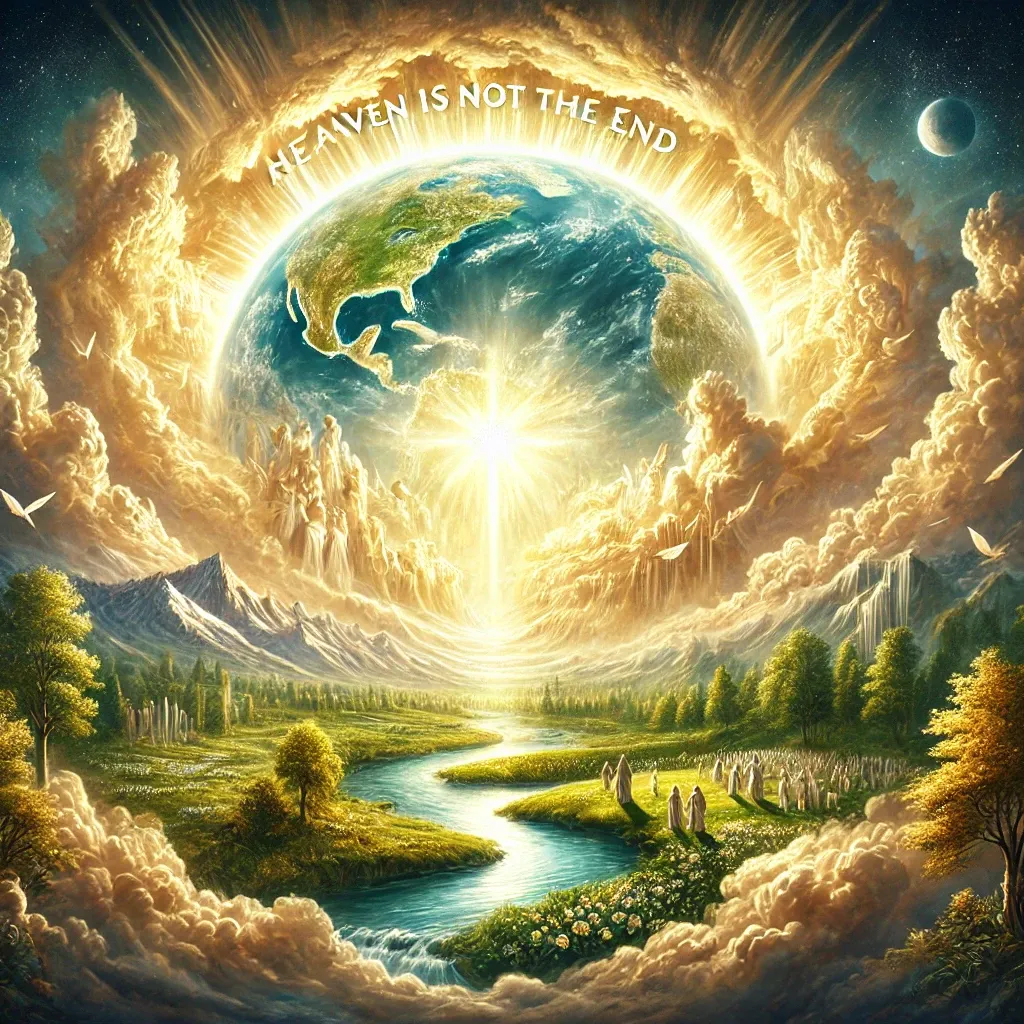

By Dr. Tim Orr
We live in a culture that talks much about legacy, but little about eternity. Funeral homes play soft music and display sentimental slogans like “Gone but not forgotten,” while popular spirituality tells us that our loved ones have “become angels” or “are watching over us.” Yet for all the poetic notions we offer, most people—even Christians—remain unsure of what actually happens when we die. In this post, I will speak to the redeemed Christian.
Is heaven the final destination? Will we have bodies? Will we recognize each other? Is our eternal future spiritual, physical—or something else entirely?
To answer these questions, we must begin not with our death but with God's design. The story of Scripture—Creation, Fall, Redemption, and Restoration—unveils not only God’s plan for the world but His plan for us as Christians. In this grand narrative, heaven is not an escape hatch. It is the climax of a redeemed cosmos, the marriage of heaven and earth, and the fulfillment of what it means to be truly human.
Act I: Creation – Earth Was Always Meant to Be Home
“In the beginning, God created the heavens and the earth” (Genesis 1:1). This opening line of Scripture isn’t just about origins—it’s about purpose. God created a physical world and called it “very good.” Humanity, made in His image, was placed in a garden—not as tourists, but as stewards (Genesis 2:15). Adam and Eve’s bodies were not temporary shells; they were integral to their identity.
N.T. Wright explains that the Hebrew vision of creation was not dualistic. Heaven and earth were not “two separate locations” but overlapping spheres of God’s reality (Wright, 2008, p. 19). The temple in Jerusalem echoed Eden’s harmony between heaven and earth. Humanity was made not to leave the earth but to fill it with the glory of God.
C.S. Lewis once wrote that the most spiritual thing you do might be eating breakfast or planting flowers—not because those things are eternal in themselves, but because God made a physical world to reflect His invisible glory. If creation was called “very good,” then the Christian hope must include its redemption, not its rejection.
When we imagine heaven, we often picture clouds and harps, not gardens and feasts. But the Bible’s beginning and end both emphasize bodily life in a renewed world. This matters because it grounds our hope—not in escape from the world but in its renewal. Heaven is not plan B. Earth is not disposable. The biblical vision is far more glorious: the world remade, not replaced.
Act II: The Fall – Death as Exile from Our True Home
But paradise was ruptured. With one act of rebellion, Adam and Eve severed the relationship that sustained life. Sin entered not only hearts but the very fabric of creation. Death—the great intruder—became our new master.
Death is not simply biological. It is relational dislocation from God, from others, and even from ourselves. Paul writes that all creation groans under this curse, longing for liberation (Romans 8:22–23). Our world feels this groaning—tsunamis, cancers, genocides—all remind us that we live in exile from Eden.
Tim Keller often reminded his listeners that “death is not the natural circle of life—it is a curse.” The ache we feel at gravesides is not a weakness of faith, but a confirmation of theology. Death feels wrong because it is wrong.
This sense of exile is what drives our unending quest for meaning. We try to recreate heaven in vacations, entertainment, career, and romance—but all fall short. As Alcorn (2004) puts it, “Nothing is more often misdiagnosed than our homesickness for heaven. We think that what we want is sex, drugs, money, a new job. What we really want is the presence of God” (p. 456).
The Fall means that we live in a disordered world where even our desires can’t be trusted. We were made for wholeness, but everything is now fragmented. And this fragmentation leads to fear—fear of aging, of loss, of death. But in God's story, this is not the final word.
Act III: Redemption – Resurrection Changes Everything
Enter Christ. The Word became flesh and dwelt among us—not to float us off to heaven, but to bring heaven to earth.
The incarnation affirms that bodies matter. The cross affirms that sin is real. And the resurrection affirms that death is not the end.
Jesus didn’t rise as a spirit or a symbol. He rose bodily. He ate fish (Luke 24:42). He showed His scars (John 20:27). He was unrecognizable at first, not because He was less physical, but more gloriously real.
This, Wright (2008) argues, is the beginning of “new creation” (p. 29). Resurrection isn’t life after death—it’s life after life after death. It's the restoration of what was lost and the glorification of what was broken.
Tim Keller called the resurrection “the hinge upon which the whole of history swings.” If Jesus rose, then death is not the terminus—it is the tunnel. As the firstfruits of the resurrection, Jesus is not the exception. He is the forerunner. What happened to Him will happen to us.
This means salvation is not about becoming less human but more human. It’s not about being delivered from the body but about being restored in it. The resurrection tells us that the material world is not the enemy—it’s the canvas for God’s glory.
Act IV: The Intermediate State – Present With Christ, But Not Yet Home
So what happens immediately after death?
The Bible teaches that believers are ushered into the presence of Christ: “Today you will be with me in paradise” (Luke 23:43). Paul says that to die is “gain” because it means being “with Christ” (Philippians 1:21–23).
This is what theologians call the “intermediate state.” Alcorn (2004) describes it as “a temporary heaven”—a place of joy, rest, and communion with Christ, but not our final destination (pp. 50–52).
We often think of this as our eternal home, but biblically, it is a waiting room—glorious, yes, but incomplete. In Revelation 6:10, the martyrs in heaven cry, “How long, O Lord?” They are at rest, yet they long for justice, resurrection, and the fullness of God’s kingdom.
An illustration may help. Imagine being adopted from a war zone and brought to a safe home. You’re no longer in danger—but you haven’t yet been reunited with your full family or restored to your birthright. The intermediate heaven is that shelter—a beautiful prelude, but not the grand finale.
In the present heaven, we are not ghosts or angels but conscious souls in God’s presence. We await the day when soul and body will be reunited, just as Christ’s was. This temporary rest is deeply comforting, but it is not the Christian's ultimate hope.
Act V: Restoration – The Marriage of Heaven and Earth
Revelation 21–22 explodes our categories: heaven comes down, earth is made new, and God dwells with humanity again. This is not a backup plan. It is the ultimate plan, promised from the beginning.
“Behold, the dwelling place of God is with man. He will wipe away every tear… and death shall be no more” (Revelation 21:3–4).
N.T. Wright says this is not about destruction but renewal: “God is not making all new things. He is making all things new” (2008, p. 104). Just as Christ’s resurrected body was physical yet glorified, so too will our eternal home be earthy yet eternal, familiar yet transformed.
Randy Alcorn offers a powerful image: “The New Earth will be Eden restored—but enhanced, enlarged, and perfected” (2004, p. 136). We will eat, laugh, build, explore, and worship in bodies that cannot perish, in a world without decay.
Will we recognize each other? Yes. Will we have purpose? Absolutely. Will we work? Yes—but without toil. Work was part of Eden before the fall; in the New Earth, it will be a joy, not a burden (Alcorn, 2004, p. 407).
Think of your most joyous moment—your wedding day, holding your newborn child, hiking a mountain trail. Now imagine never having to say goodbye to that moment. That’s not wishful thinking. That’s Revelation realism.
Even the mundane moments will be redeemed. Imagine meals with Abraham and Sarah, walks with David, conversations with C.S. Lewis. But more than that—imagine seeing Christ face to face and living in the full light of His love without shame, fear, or sin. That is the heartbeat of heaven.
Living in Light of Eternity
The biblical vision of heaven is not meant to make us complacent. It is meant to fuel courage.
Theologian Jürgen Moltmann once said, “Hope is the present tense of the future.” Because we know what’s coming, we can endure suffering, fight injustice, and weep with hope. As Paul says, our labor is not in vain (1 Corinthians 15:58).
Keller told the story of a young girl who lost her toy in a house fire. Her father restored it from memory—every stitch, every patch. When he gave it back to her, she gasped, “It’s the same—but better.” That is our future. Not the erasure of life, but its glorification.
We’re not waiting to be snatched out of this world. We’re waiting for the return of the King, who will raise the dead, heal the earth, and make His dwelling with us again.
So what happens when we die?
We go to be with Christ. But that’s not the end. It’s only the beginning.
References
Alcorn, R. (2004). Heaven. Tyndale House Publishers.
Keller, T. (2021). Hope in Times of Fear: The Resurrection and the Meaning of Easter. Viking.
Wright, N. T. (2008). Surprised by Hope: Rethinking Heaven, the Resurrection, and the Mission of the Church. HarperOne.
Who is Dr. Tim Orr?
Tim serves full-time with Crescent Project as the assistant director of the internship program and area coordinator, where he is also deeply involved in outreach across the UK. A scholar of Islam, Evangelical minister, conference speaker, and interfaith consultant, Tim brings over 30 years of experience in cross-cultural ministry. He holds six academic degrees, including a Doctor of Ministry from Liberty University and a Master’s in Islamic Studies from the Islamic College in London.
In addition to his ministry work, Tim is a research associate with the Congregations and Polarization Project at the Center for the Study of Religion and American Culture at Indiana University Indianapolis. His research interests include Islamic antisemitism, American Evangelicalism, and Islamic feminism. He has spoken at leading universities and mosques throughout the UK—including Oxford University, Imperial College London, and the University of Tehran—and has published widely in peer-reviewed Islamic academic journals. Tim is also the author of four books.
